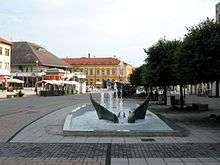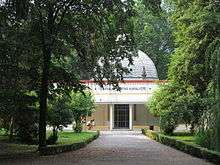Daruvar
| Daruvar | ||
|---|---|---|
| Town | ||
| City of Daruvar Grad Daruvar Město Daruvar [1] | ||
|
Main street in Daruvar | ||
| ||
 Daruvar Location of Daruvar in Croatia | ||
| Coordinates: HR 45°35′34″N 17°13′25″E / 45.592895°N 17.223685°E | ||
| Country |
| |
| County |
| |
| Government | ||
| • Mayor | Dalibor Rohlik (SDP) | |
| Area | ||
| • Total | 64 km2 (25 sq mi) | |
| Population (2011) | ||
| • Total | 11,633 (municipality) | |
| Time zone | CET (UTC+1) | |
| • Summer (DST) | CEST (UTC+2) | |
Daruvar (Czech: Daruvar, German: Daruwar, Hungarian: Daruvár, Latin: Aqua Balissae) is a spa town in Slavonia, northeastern Croatia, with a population of 8,567, as of 2011.[2] It is located on the foothills of Papuk mountain and along the Toplica river. The main political and cultural centre of the Czech national minority in Croatia, it has a winemaking tradition reportedly dating back more than 2000 years.
Geography
- Coordinates: 45°35′26″N 17°13′30″E / 45.590555°N 17.225°E
- Area: 64 km2
- Altitude: 190 m
Daruvar is located 125 km from Zagreb, the national capital, and 130 km from Osijek, the main city of Slavonia to the east. The closest cities are: Pakrac, Lipik, Novska, Križevci, Bjelovar, Virovitica.
Administration
Daruvar is located in the Bjelovar-Bilogora County. The list of settlements within the city limits is:[2]
- Daruvar, population 8,567
- Daruvarski Vinogradi, population 164
- Doljani, population 759
- Donji Daruvar, population 731
- Gornji Daruvar, population 436
- Lipovac Majur, population 83
- Ljudevit Selo, population 252
- Markovac, population 80
- Vrbovac, population 561
History


Archaeological findings here, (stone axes), could be traced back to the stone age. The history of Daruvar could be traced to the 4th century BC, when the first organized habitation emerged near the warm geothermal spas in today's Daruvar valley. Celtic - Pannonian tribes living here and familiar with water treatments benefiting health, were Iassi, (meaning healers), so called by both Greek and Roman writers.
As allies of the Roman Empire, the tribes provided support to Emperor Augustus during the siege of Siscia, (today's Sisak), and in year 35, Iassi were granted local autonomy known as Res Publica Iasorum. The center of it was Aqua Balissae, meaning very strong springs. In the year 124, during the reign of Hadrian, the area gained additional autonomy as Municipium Iassorum. Stretching between the rivers Sava and Drava, on the roads which ran between Siscia-Mursa, (Sisak- Osijek), Salona–Aquincum, Sirmium–Poetovio, it was easy to access. As did Hadrian, emperors Marcus Aurelius, Commodus, Septimius Severus and Constantine I, all visited Aqua Balissae's thermal complex, its decorated temple, its forum and its, (though not as big as the one in Pula), amphitheatre.
In the 11th century the region became part of a mightier entity, that of the rapidly growing and politically important city of Križevci. Within, it became part of the archdiocese of Zagreb mentioned by legislators for the first time in 1334. Since the city was on a busy crossroads, there were four trading points within the valley — Četvrtkovac, Dimičkovine, Podborje and Toplice, (toplice=spas in Croatian). And, as it was more than millennium ago, pleasant spas kept attracting people. The population in that period was exclusively Catholic.
In the 15th and 16th centuries, all that changed. Expansion of the Ottoman Empire disrupted the steady development and Turks occupied lands here in 1543. The Monastery of St King Ladislaus was degraded, becoming a Turkish defensive post looking into the Krajina, military zone created to protect the Habsburg Empire just west of the city. Local people fled from Turks. Turks were expelled in 1699 and the now ethnically mixed area came under the rule of Vienna in 1745. Podborje, Sirač and Pakrac were bought by count Antun Janković who in 1771 renamed Podborje as Daruvar, (daru=crane in Hungarian), after a building of his own called the Crane's castle. In 1837 Daruvar was declared a free city by decree of king Ferdinand I. Empty lands were repopulated by people skilled in crafts, trade, agriculture from around Croatia and beyond. Germans, Hungarians, Czechs, Italians, (around so called Little Italy) and others were invited to come. In the late 19th and early 20th century, Daruvar was part of the Požega County of the Kingdom of Croatia-Slavonia. Daruvar was briefly captured by militants from the Serbian Autonomous Oblast of Western Slavonia during the Croatian War of Independence.
Climate
| Climate data for Daruvar | |||||||||||||
|---|---|---|---|---|---|---|---|---|---|---|---|---|---|
| Month | Jan | Feb | Mar | Apr | May | Jun | Jul | Aug | Sep | Oct | Nov | Dec | Year |
| Average high °C (°F) | 3 (37) |
6 (42) |
11 (52) |
14 (58) |
21 (69) |
23 (74) |
26 (79) |
26 (78) |
22 (71) |
16 (60) |
8 (47) |
4 (40) |
15 (59) |
| Average low °C (°F) | −2 (29) |
−1 (31) |
3 (38) |
7 (45) |
12 (54) |
15 (59) |
17 (62) |
16 (60) |
12 (54) |
8 (46) |
3 (37) |
0 (32) |
8 (46) |
| Average precipitation mm (inches) | 53 (2.1) |
53 (2.1) |
48 (1.9) |
79 (3.1) |
86 (3.4) |
109 (4.3) |
86 (3.4) |
86 (3.4) |
61 (2.4) |
69 (2.7) |
81 (3.2) |
74 (2.9) |
881 (34.7) |
| Source: Weatherbase [3] | |||||||||||||
Demographics
According to the census of 2011, the population of the Daruvar municipality (township) was 11,633. In ethnic terms, 61.28% are Croats, 21.36% Czechs, 12.28% Serbs and 0.98% Hungarians.[4] As for the religion, 75.49% are Catholics, 10.23% Orthodox, and 7.62% are agnostics and atheists.[5]
The Czech population is of significant size having its own newspaper, schools, societies and clubs, (Česká beseda or Czech word, Jednota - Unity in Czech language), publishing company. The entire area, (Veliki Zdenci, Grubišno Polje, Končanica), is actually bilingual with Czech being the second official language. There are numerous local ethnic festivities celebrating important points in different cultures — youth, harvest etc. with most interesting and picturesque that of the Czech minority.
Spas
Water treatments benefiting health were well known to mentioned Iassi tribes here almost 2500 years ago, later widely used by Romans and in the Middle Ages. In 1772 owner of the area Antun Janković started building around the springs, envisioning correctly that the town might become healing, leisure and recreation center again as it was proven through the course of history. He erected numerous buildings, many of them still functional -- (Anton's spa, Ivan's spa ). After 1897 newly opened railroad brought new visitors. Restaurant Teresa, Swiss villa, Villa Arcadia, Big Mud Spa with its prominent dome and today well known city mark were all built during the turn of 19 and 20th century.
Daruvarske Toplice is a special hospital complex for rehabilitation specializing in treatment of female fertility (primary and secondary sterility), with two clinics for esthetic surgery. Warm waters (33 to 47 °C) are also used in postoperative rehabilitation, treatment of inflammations, rheumatism, the trauma of bones, hips, head, spine, and locomotion. More spas are around Pakrac and Lipik where there is also a mineral water bottling plant. The park within the complex is positioned containing 65 different kind of trees like 250-year-old Ginkgo tree from China, Variegatum from Arizona and others. Pleasant Hotel Termal renovated and extended in 1996 is also here. The smaller one, Balisse is just few minutes walking distance from here in the traffic friendly downtown.
Tourism
The Area is rich in monuments. Historic Kistalovac, Pavlovina, Sirač, Bagenovać, Dobra Kuća, Stupčanica are examples of numerous local castles belonging to the Croatian nobility of the times passed by. Franciscan monasteries like that ones of St. Margareth, St. Ana, St. three kings, Church of Holy Trinity are witnesses of the rich religious culture.
Economy
German people who came here in the 18th century as well Czechs in the 19th were the keystone of the revival participating in agriculture, food processing plants, culture and education. The development was accelerated on the turn of the centuries by being connected to the railroad track from Banova Jaruga to Barcs in Hungary. Important historic moment was in 1897 witnessed by the emperor Franz Joseph himself. Since 1840 a brewery is operating here producing today more than 250,000 hectoliters of beer based upon old and famous Czech recipes, with Old Bohemian, (Staročeško pivo), brand being the most known. Zdenka of Veliki Zdenci is well known for its milk and melted cheese processing plant.
Fish is cultivated in artificial lakes around Končanica and processed within Irida. Here are local high quality vines as Graševina, (ranking the highest), Rhein Riesling, Chardonnay and Sauvignon. Here are fruit, maize, wheat, meat and other agriculture products produced for local, national and wider market s. Dalit, created in 1905, is a metal processing plant once one of the biggest in what was once Yugoslavia, employing today 320, but in the late 70es almost 2000 people. Flat glass factory is in Lipik. There are small graphics and printing, (Daruvarska Tiskara d.d., Logos), facility and textile plant Vesna which is employing around 200. Growing is the importance of the trade, tourism and communication. 2300 people are employed one third of them women.
Education
The first school was opened in 1856. A school for women was opened here in 1866.
Notable people
- Eva Fischer - oil artist
- David Frankfurter - Croatian Jew known for assassinating Swiss branch leader of the German NSDAP Wilhelm Gustloff in 1936 in Davos, Switzerland
See also
References
- ↑ "Registar Geografskih Imena Nacionalnih Manjina Republike Hrvatske" (PDF). Retrieved 2013-03-08.
- 1 2 "Population by Age and Sex, by Settlements, 2011 Census: Daruvar". Census of Population, Households and Dwellings 2011. Zagreb: Croatian Bureau of Statistics. December 2012. Retrieved 28 December 2012.
- ↑ "Weatherbase: Historical Weather for Daruvar, Croatia". Weatherbase. 2011. Retrieved on November 24, 2011.
- ↑ "Population by Ethnicity, by Towns/Municipalities, 2011 Census: County of Bjelovar-Bilogora". Census of Population, Households and Dwellings 2011. Zagreb: Croatian Bureau of Statistics. December 2012. Retrieved 28 December 2012.
- ↑ "Population by Religion, by Towns/Municipalities, 2011 Census: County of Bjelovar-Bilogora". Census of Population, Households and Dwellings 2011. Zagreb: Croatian Bureau of Statistics. December 2012. Retrieved 28 December 2012.
External links
| Wikimedia Commons has media related to Daruvar. |
- Daruvar official site (Croatian)
- Daruvar city portal (Croatian)
- Daruvarski Portfolio (Croatian)
.png)
